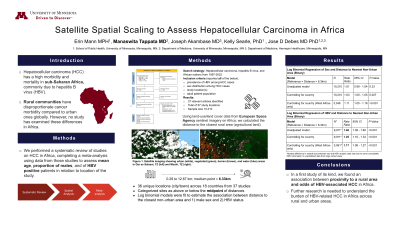Monday Poster Session
Category: Liver
P2380 - Satellite Spatial Scaling to Assess Hepatocellular Carcinoma in Africa
Monday, October 23, 2023
10:30 AM - 4:15 PM PT
Location: Exhibit Hall

Has Audio
- MT
Manaswita Tappata, MD
University of Minnesota
Minneapolis, MN
Presenting Author(s)
Erin Mann, MPH1, Manaswita Tappata, MD1, Joseph Akambase, MD2, Kelly Searle, PhD1, Jose Debes, MD, PhD1
1University of Minnesota, Minneapolis, MN; 2Hennepin Healthcare, Minneapolis, MN
Introduction: Hepatocellular carcinoma (HCC) has a high morbidity and mortality in sub-Saharan Africa, commonly due to hepatitis B (HBV). Rural communities experience disproportionate cancer morbidity compared to urban ones globally. However, no study has examined these differences in Africa.
Methods: We performed a systematic review of studies on HCC in Africa, completing a meta-analysis using data from those studies to assess mean age, proportion of males, and of HBV positive patients in relation to location of the study. Using land-use/land cover data available from European Space Agency sentinel imagery on Africa, we categorized locations and calculated the distance in kilometers from each study site to the closest rural area (agricultural land). These distances were divided into quartiles. Logistic regression models were fit to estimate 1) the association between distance to the closest rural area and HBV and 2) the association between distance to the closest rural area and gender. Weighted mean age was calculated for each quartile.
Results: 978 studies were retrieved via electronic database search. Duplicates were removed, after reviewing for relevance, fifty-seven articles were included. Data on 10,608 patients was used in the meta-analysis across 19 countries in Africa. 74% of patients were male with weighted mean age 52.5 years. Proximity to a rural area was associated with increased odds of HBV after controlling for country, with locations closest to a rural region (< 3.2km) having 3.1 times higher odds of HBV-HCC (95% CI 2.65 - 3.60, p < 0.001) compared to patients in locations furthest from rural areas ( >9.5km). When analyzing only studies in West Africa, those in locations closest to rural areas also showed higher odds of HBV-HCC (OR: 1.43, 95% CI 1.15-1.76, p< 0.001) compared to those furthest from rural areas. However, patients in studies between 6.3 and 9.5km had decreased odds of HBV (OR: 0.42, 95% CI 0.28 – 0.63, p< 0.001). No association was found between proximity to a rural area and gender or age (50, 53, 47 and 53 y/o respectively per distance quartile).
Discussion: In a first study of its kind, we found an association between proximity to a rural area and odds of HBV-associated HCC in Africa. Further research is needed to understand the burden of HBV-related HCC in Africa across rural and urban areas.
Disclosures:
Erin Mann, MPH1, Manaswita Tappata, MD1, Joseph Akambase, MD2, Kelly Searle, PhD1, Jose Debes, MD, PhD1. P2380 - Satellite Spatial Scaling to Assess Hepatocellular Carcinoma in Africa, ACG 2023 Annual Scientific Meeting Abstracts. Vancouver, BC, Canada: American College of Gastroenterology.
1University of Minnesota, Minneapolis, MN; 2Hennepin Healthcare, Minneapolis, MN
Introduction: Hepatocellular carcinoma (HCC) has a high morbidity and mortality in sub-Saharan Africa, commonly due to hepatitis B (HBV). Rural communities experience disproportionate cancer morbidity compared to urban ones globally. However, no study has examined these differences in Africa.
Methods: We performed a systematic review of studies on HCC in Africa, completing a meta-analysis using data from those studies to assess mean age, proportion of males, and of HBV positive patients in relation to location of the study. Using land-use/land cover data available from European Space Agency sentinel imagery on Africa, we categorized locations and calculated the distance in kilometers from each study site to the closest rural area (agricultural land). These distances were divided into quartiles. Logistic regression models were fit to estimate 1) the association between distance to the closest rural area and HBV and 2) the association between distance to the closest rural area and gender. Weighted mean age was calculated for each quartile.
Results: 978 studies were retrieved via electronic database search. Duplicates were removed, after reviewing for relevance, fifty-seven articles were included. Data on 10,608 patients was used in the meta-analysis across 19 countries in Africa. 74% of patients were male with weighted mean age 52.5 years. Proximity to a rural area was associated with increased odds of HBV after controlling for country, with locations closest to a rural region (< 3.2km) having 3.1 times higher odds of HBV-HCC (95% CI 2.65 - 3.60, p < 0.001) compared to patients in locations furthest from rural areas ( >9.5km). When analyzing only studies in West Africa, those in locations closest to rural areas also showed higher odds of HBV-HCC (OR: 1.43, 95% CI 1.15-1.76, p< 0.001) compared to those furthest from rural areas. However, patients in studies between 6.3 and 9.5km had decreased odds of HBV (OR: 0.42, 95% CI 0.28 – 0.63, p< 0.001). No association was found between proximity to a rural area and gender or age (50, 53, 47 and 53 y/o respectively per distance quartile).
Discussion: In a first study of its kind, we found an association between proximity to a rural area and odds of HBV-associated HCC in Africa. Further research is needed to understand the burden of HBV-related HCC in Africa across rural and urban areas.
Disclosures:
Erin Mann indicated no relevant financial relationships.
Manaswita Tappata indicated no relevant financial relationships.
Joseph Akambase indicated no relevant financial relationships.
Kelly Searle indicated no relevant financial relationships.
Jose Debes indicated no relevant financial relationships.
Erin Mann, MPH1, Manaswita Tappata, MD1, Joseph Akambase, MD2, Kelly Searle, PhD1, Jose Debes, MD, PhD1. P2380 - Satellite Spatial Scaling to Assess Hepatocellular Carcinoma in Africa, ACG 2023 Annual Scientific Meeting Abstracts. Vancouver, BC, Canada: American College of Gastroenterology.
